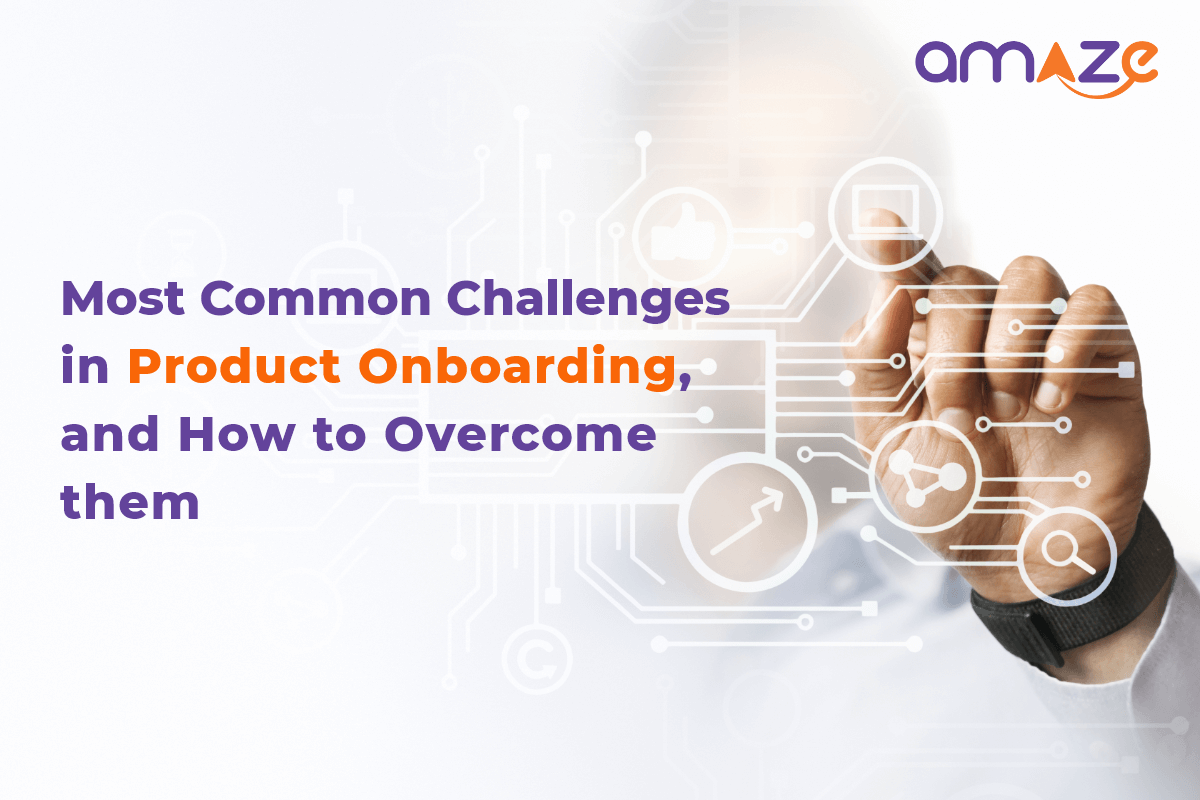Most Common Challenges in Product Onboarding, And How to Overcome Them – Amaze PXM

Most Common Challenges in Product Onboarding, And How to Overcome Them
As businesses look to expand their digital footprint, the process of product onboarding can be long, arduous, and prone to errors. Knowing about these obstacles is half the battle won; mitigating them with the right processes and platform is the other.
By definition, product onboarding is the first and most important step of introducing a product to your customer. And it all starts with the introduction of a product to your system. While the product, in essence, gets to the destination (your customer), a lot of data could be lost, duplicated or misrepresented along the way.
Why does product onboarding fail?
The failure of product led onboarding is most commonly the result of, not one, but a combination of factors taking effect across touchpoints. Here are some of the most common obstacles faced by companies when onboarding products:
- SaaS ‘learning curves’ : While SaaS solutions may come pre-built and customized for specific business requirements, they still have a ‘learning curve,’ during which teams train and fine-tune these systems to optimize product onboarding. For some platforms, this curve tends to extend for a longer duration of time, negatively impacting customer experience and taking a hit on ROI.
- Data alignment : As products make their way from multiple sources (manufacturers, suppliers etc.) teams find themselves dealing with a deluge of data with varying schematic characteristics. Relevant as the data may be, differences in data quality and definitions lead to duplication, loss, and errors in data which hamper product experience.
- Platform interface : Product onboarding software with great capabilities may also go underutilized as they are too complicated to use and not fully leveraged by teams.
- Team training & alignment : No two individuals interact with a software in the same way. As multiple stakeholders get involved in product onboarding, their understanding and use of the SaaS platform can also impact the process. Even with intuitive SaaS platforms, the software’s potential is often not put to full use, as teams are not trained on how to get the most out of the platform.
- Validation : Many platforms used for product onboarding don’t have the required validation functions to spot discrepancies in data quality and raise the required flags in the workflow. This directly increases the chances of a product going online with inaccurate or inconsistent information.
- Justifying the investment : With these obstacles at play, inefficient product onboarding platforms tend to create more problems than they solve. This leads to decreased trust in platform adoption, and also makes it harder to justify the need for continuing to invest in a product onboarding platform, as growth in ROI is not achieved.
Here’s a simple, yet typical scenario where poor product onboarding processes can directly impact customer experience: Product information received from a vendor provides product dimensions in centimeters (metric system), however, the business’s eCommerce website requires these measurements in inches (imperial system). The lack of a validation mechanism means that the issue is not flagged. So, the product goes through with the centimeter value, but with ‘inches’ as the unit of measurement.
The team, not adequately trained in the end-to-end workflow, fails to spot that the product also doesn’t have the required images to go online. However, since he/she is not aware of the mechanism to raise the flag, the product goes further still. Again, the platform has no validation system to spot the missing image, and the product finally finds its way online.
The result – the customer sees the product online without any image to be able to relate to the product. The dimensions don’t make any sense, and the customer finds very little reliable information to go ahead with the purchase. Sale opportunity lost, customer lost.
Product Onboarding Best Practices: How to Get it Right!
The answer is simple. Find a product onboarding platform that makes the process easier, and you’ll find your business reaping the benefits of an automated, streamlined process. But how does one select this platform? Read on to learn more:
- Create and optimize a structured onboarding process. Make sure the selected platform is capable of implementing this process with minimum manual intervention.
- Ensure that the selected platform gives you all the data you need to gauge the efficacy of your onboarding strategy. It should allow you to course-correct and fine-tune as and when you update strategy.
- Pick a platform that has robust validation mechanisms to set data rules and flag data integrity issues when identified.
- Let end-users lead the way. Ensure that the platform is designed and optimized for end-users, in a way that they can leverage the platform to the fullest, eventually maximizing business benefits.
- Identify a platform that is agile and adaptable. The platform must be responsive to user inputs, and adaptable to change with minimum or no business impact.
- Find a platform that is easily learnable by end-users. It must support modules that give your teams access to the information they need, in the format that they need it.
The journey of creating a great customer experience starts, not from search, not from website visits, but from the first touchpoint where you receive product information. Setting the process right at this stage ensures a solid foundation for a better product experience and also, better customer experience.
Click to request a demo today: https://amazepxm.com/amaze-demo/index.html
Related Articles
Recent Post
Categories





